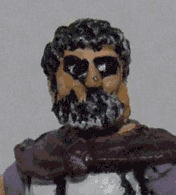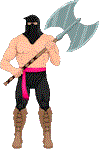Armies from 1066 or later at Irvine 2023
Ottoman Turkish vs 100YW French
Game 1 Ottoman Turkish vs Feudal Scots
Game 2 Ottoman Turkish vs 100YW French
Game 3 Ottoman Turkish vs Arab Indian
Game 4 Ottoman Turkish vs Norman
Game 5 Ottoman Turkish vs Albanian
With one game under their belts the Ottomans were now starting to wonder if the rather scratch list they had assembled and only had one very, very unsuccessful practice game with beforehand might actually be half decent
Disappointingly, lunch seemed not to involve any neeps, tatties or deep fried confectionary items but instead a rather healthy selection of baked potatoes and both meat and veg chilli - hopefully the meat was something unspeakable and full of unhealthy diced intestines and internal organs of unnamed animals, as otherwise Scotland's proud reputation for culinary arterial congestion would not be upheld that day
The second round saw the Ottomans taking on the 100YW French - a matchup of mounted horsefoolery vs heavy metal medieval mayhem.
During the Hundred Years' War, which lasted from the 14th to the 15th century, French armies consisted of several main troop types that evolved over the course of the conflict. These troop types included:
Knights and Men-at-Arms: The French army heavily relied on knights and men-at-arms, who were heavily armored cavalry mounted on powerful warhorses. These elite warriors were equipped with lances for charging enemy lines and swords for close combat. They formed the core of the French feudal nobility and were instrumental in traditional chivalric warfare.
Archers: French armies incorporated archers, though to a lesser extent than the English. French archers used the longbow and crossbow and were often employed for ranged support and harassment. Over time, the French increased their use of archers, adopting longbows to counter the effectiveness of English archery.
Infantry: Infantry played a significant role in French armies, with a focus on dismounted men-at-arms and militia. These foot soldiers included halberdiers, billmen, pastry chefs and pikemen who formed defensive formations to counter enemy cavalry charges. Infantry also served as a supporting force to protect flanks and provide a solid core for the French army.
Cavalry: In addition to knights and men-at-arms, French armies also included lighter cavalry forces such as mounted archers, scouts, bicycle-mounted onion sellers in striped jerseys wearing berets and generic skirmishers. These cavalry units were used for reconnaissance, harassment of enemy formations, onion soup ingredient distribution and exploiting openings in the enemy lines.
Crossbowmen: French armies employed crossbowmen, particularly in the early phases of the war. Crossbowmen provided additional ranged firepower and were often used alongside other troop types to weaken enemy formations before engaging in close combat.
Artillery: As the Hundred Years' War progressed, the French started to incorporate artillery into their armies. Cannons and other siege weaponry were used for besieging castles and fortifications, as well as for direct engagement on the battlefield.
Mercenaries and Allies: Throughout the war, the French employed mercenaries and allied forces from various regions, including Genoese crossbowmen and Scottish troops. These units added diversity to the French armies and brought different combat styles and tactics.
The composition of French armies evolved in response to the changing dynamics of the war, adapting to the challenges posed by English tactics, particularly the effective use of longbow archers. Over time, the French increased their reliance on combined arms tactics, incorporating a variety of troop types to create a more balanced and versatile fighting force.
The lists for the Ottoman Turkish and 100YW French from this game, as well as all the other lists from the games at Irvine can be seen here in the L'Art de la Guerre Wiki.
The French army was tiny, all well armoured and equipped with heavy knights dismounted on foot ready to advance through a blizzard of English longbow shooting in a narrow defile
On the flip side however, the terrain had fallen extremely well for the Ottomans as they had managed to bring the French army to battle on a near-open plain leaving the Gallic contingent nowhere to anchor their flanks.
the French resolved to form a defensive bastion as best they could, as the Ottomans prepared to sweep forward across the steppe-like plain and seek to draw out the solid line of well protected infantrymen

Scotland's Royal Family
As the sun begins to reach it's zenith (OK, in Scotland, so it's still overcast anyway) over the vast open field, a tense silence settled upon the field of play.
The formidable army of dismounted knights, their polished plate armour reflecting the murky light show a steely resolve (see what I did there?) as they do their best to form a disciplined formation, shields locked and spears poised.
Across the field, the Turks gallop towards them at pace, arrows notched at the ready.
from the distant horizon emerges a thunderous gallop, the ground trembling beneath the hooves of mighty medieval steeds as the French unleash their handful of still-mounted Knights to move out and protect thee left flank of their defensively arrayed army.
Facing them is the glint of armour and the flutter of banners, as the Ottoman cavalry haver into view

The Ottomans intricate leather armour is adorned with brilliant textiles, most of which are painted in simple block colours in a rather shocking admission of painting incompetence and lack of attention to detail om my part.
The commander of the Ottoman cavalry, adorned with a feathered helm, raises his scimitar and urges his men forward secure in the knowledge that he is not likely to do any fighting himself as he is not one of the Included commanders in the Ottoman army list this day
the Ottomans close to short range to begin their campaign of harassment against the mainly pedestrian foe.
Their horses surge forward, manes flying like banners of their own as their riders determined eyes focus on the enemy riders and the already sweating plate-clad infantry
On the opposite wing the Ottomans have a vast superiority in numbers.
As the distance closes, the Ottoman cavalry and infantry seamlessly divide into smaller units, each manoeuvring with uncanny precision to take up shooting positions or to harass the flanks of the static Frenchmen.
The Janissaries and Sipahis composite bows are drawn as one, and a rain of arrows takes flight. The knights, encased in heavy armour, are gripped by fear as they are already hard-pressed to avoid the deadly projectiles.

The French knights, encased in heavy armour, face up against the aggressive press from the Ottoman cavalry, Even so, some arrows find their marks, penetrating gaps in the knights armour or striking horses' unprotected flesh.
The attention of the Knights is fully focused on the Siphai, allowing yet more Ottoman horsemen to slip behind the French lines. Realising their flanks are compromised, panic spreads among the knights, and their once-impenetrable formation falters.
The Ottoman cavalry and Janissaries on the other flank regroup, wheeling their horses around for another pass.
both mounted and infantry archers continue to pepper the line of foot knights with arrows, keeping them off balance, unable to fully regroup to counter the many probing thrusts of Ottoman horsemen.
The foot knights, burdened by the weight of their armour, struggle to manoeuvre themselves to counter the agility of the Ottoman mounts.

Scottish Laundry-related Incident
 The French foot knight brows were now soaked in sweat, their frustration palpable even for such small scale figures as they grappled with the relentless onslaught of Ottoman cavalry pressing them from all sides
The French foot knight brows were now soaked in sweat, their frustration palpable even for such small scale figures as they grappled with the relentless onslaught of Ottoman cavalry pressing them from all sides
Inexorably, the Ottoman cavalry's hit-and-run tactics continue to take a toll, their arrows chipping away at the French foot knights' defences and morale as they pressed forward to position themselves for deadly flank charges as well.
a knight in full plate armour engages in a one-on-one duel with an Ottoman rider.
The clashing of steel against steel echoes in the air as the two warriors exchange blows.
The Ottoman cavalryman's agility grants him an edge, his strikes probing for haggis-soft weaknesses in the knight's armour.

The Ottoman commander on the right gives another signal, and almost all of the Ottoman cavalry pull back, their retreat a well-coordinated dance that leaves the French knights in a state of confusion, and the Ottoman cavalry regrouping on a distant rise.
There is a crescendo of thundering hooves and the flurry of movement as the Ottoman cavalry expertly wield their curved sabres, striking with calculated ferocity as they attack the exposed left flank of the French line.
Scottish Regimental Tactics
The Ottoman attacks were now multiplied by the ferocity of the Iyalars, sweeping in to assault the front of the already fully embattled foot knights.
Suddenly the French left collapses, the field of battle littered with wounded knights tending to their fallen comrades,
the Ottomans on the right keep falling ever further back - pursued by increasingly exhausted plate-clad Frenchmen. The Ottoman commanders have decided that this half of the battlefield is on where they will seize the initiative and refuse to fight
The battle is to be decided at a time and place of the Sultans choosing - and here is not a place his choice has settled upon

the Ottoman cavalry regroup, then slam in again to the French centre, having already totally surrounded and then efficiently eliminated the right wing of the French army in a devastating display of well timed aggression and accurate archery
The Ottomans have used their mobility to the full to swing the axis of attack through 90 degrees, totally wrong-footing the static defensive plans of the French King blah
This thrilling confrontation between two distinct forces, each showcasing their strengths and vulnerabilities, has drawn to a decisive close.
The Ottoman cavalry's calculated tactics and mobility have come out on top in this clash against the unyielding might of the French knights and their full plate armour, in a mesmerizing display of historical warfare.

The Result is a significant Ottoman victory, with only 4 break points lost.
Click here for the report of the next game in this competition, or read on for the post match summaries from the Generals involved, as well as another episode of legendary expert analysis from Hannibal
Post Match Summary from the Ottoman Turkish Commander

We, the Ottomans, are masters of strategy, and we knew that to defeat such a foe, we had to employ cunning and wit. Our illustrious cavalry, the envy of the world, lured these so-called knights out of formation with feigned flights. Oh, how they took the bait, like greedy peasants chasing after a wheel of camembert!
Picture it - the French knights, their shiny armor clattering, their horses galloping like scared rabbits as they pursued our deceptive retreats. Little did they know that they were playing right into our hands, like a flock of geese heading straight for the pot!
And then, the moment of truth arrived. With a flourish of our banners, our cavalry turned around, riding down upon the disarrayed knights like a tempest. Their formation shattered like a delicate soufflé collapsing under its own weight. Our sabers gleamed like fine wine in crystal goblets, and the clash of steel against steel echoed through the French countryside.
The once-proud French knights, with their empty boasts of chivalry and culinary clichés, found themselves humbled in the dust. Our victory was as sweet as a crème brûlée, and their defeat as bitter as the tears of a Bordeaux sommelier.
Today, we stand victorious, our banners fluttering over the Eiffel Tower - a symbol of our dominion over the land of cheese and baguettes. Let this serve as a lesson to all who dare oppose the Ottoman Empire. We are not just conquerors; we are the embodiment of victory, the pinnacle of power, and the ultimate arbiters of fate. Our empire's greatness knows no bounds, and with me at its helm, it shall shine brighter than the gleam of a freshly polished silver spoon.
Hannibal's Post Match Analysis
 Today, I find myself again in the rather peculiar position of offering half-hearted congratulations to an Ottoman Sultan, of all things, who goes by the rather whimsical name of Sultan McTavish, and who happens to have Scottish roots, no less. It appears that this Sultan McTavish has led his army to victory against a Medieval French army during the tumultuous period known as the Hundred Years' War.
Today, I find myself again in the rather peculiar position of offering half-hearted congratulations to an Ottoman Sultan, of all things, who goes by the rather whimsical name of Sultan McTavish, and who happens to have Scottish roots, no less. It appears that this Sultan McTavish has led his army to victory against a Medieval French army during the tumultuous period known as the Hundred Years' War.
While it is customary to extend a measure of courtesy in such situations, I must admit that my congratulations are tinged with a certain bemusement, given methinks thou hast the mental acumen of a Turkish rug, intricate in appearance but lacking substance beneath. Sultan McTavish, you have achieved what you consider to be a feat of military accomplishment. However, it is abundantly clear that my own brilliance as a military leader would have secured a far more decisive and efficient victory, with considerably less loss of life among my men.
The Ottoman Empire's baffling refusal to adopt the use of elephants in warfare remains a perplexing enigma to me. It's akin to an artist refusing to embrace the vibrant colors on their palette, instead choosing to paint with shades of grey. My mastery of the elephant in battle would have made victory over the French as effortless as capturing the sweet, dulcet tones of a French pop star's love ballad.
Sultan McTavish, your victory is, in some strange and twisted way, commendable, but it pales in comparison to the victories I achieved in my time. My triumphs, like the symphonies of a maestro, resonated with precision and brilliance, and left no room for the discordant cacophony of incompetence.
In conclusion, Sultan McTavish, Thou art a pudding-brained Turk, whose thoughts wander as aimlessly as a camel in a desert mirage so while I begrudgingly offer my acknowledgment of your victory, it is essential to remember that true military mastery is an art that transcends mere happenstance. May the Ottoman Empire learn from its missteps and elevate itself to a level of strategic insight that befits a great empire.
Long live the legacy of Hannibal, the unmatched general of history, and may the Ottoman Empire find its way out of the quagmire of mediocrity, where the likes of French pop stars and cultural figures are better suited than its leaders to taking this army forward into the next game
Click here for the report of the next game in this competition
You may also like....
Game 1 Ottoman Turkish vs Feudal Scots
Game 2 Ottoman Turkish vs 100YW French
Game 3 Ottoman Turkish vs Arab Indian
Game 4 Ottoman Turkish vs Norman
Game 5 Ottoman Turkish vs Albanian
View My Stats for My Match Reports Pages






























